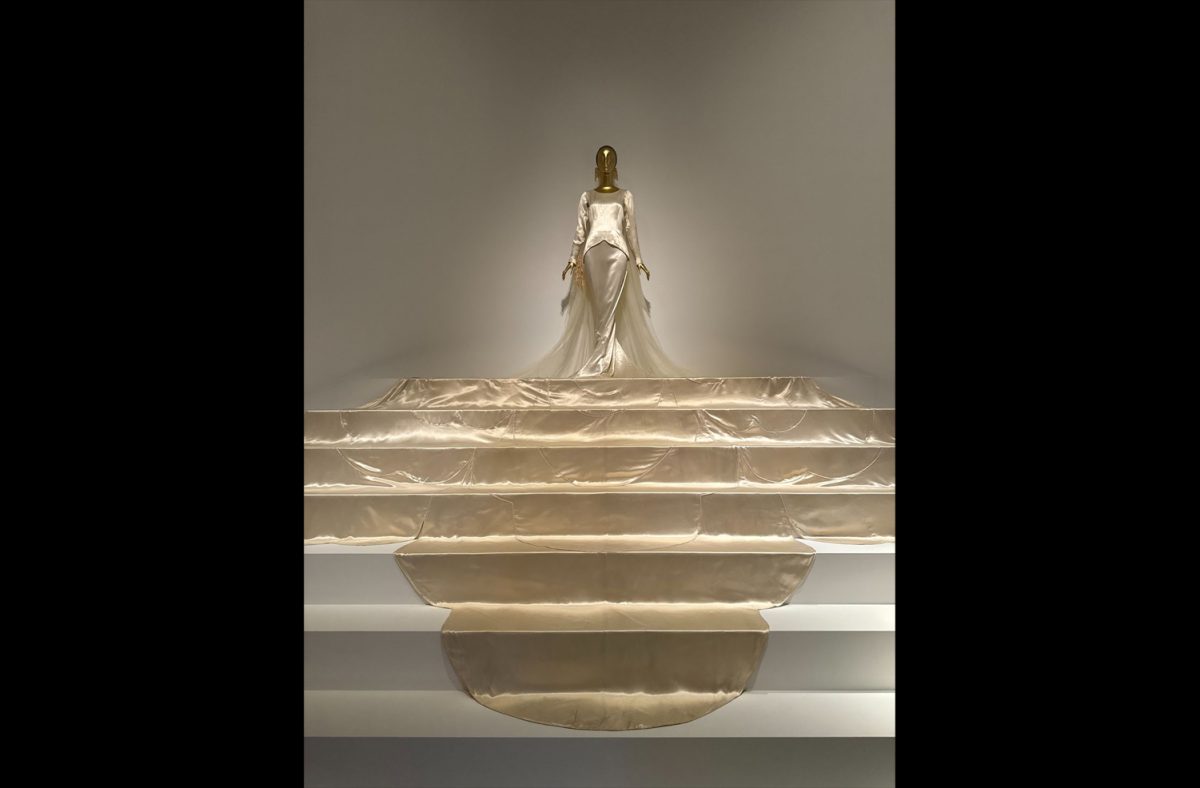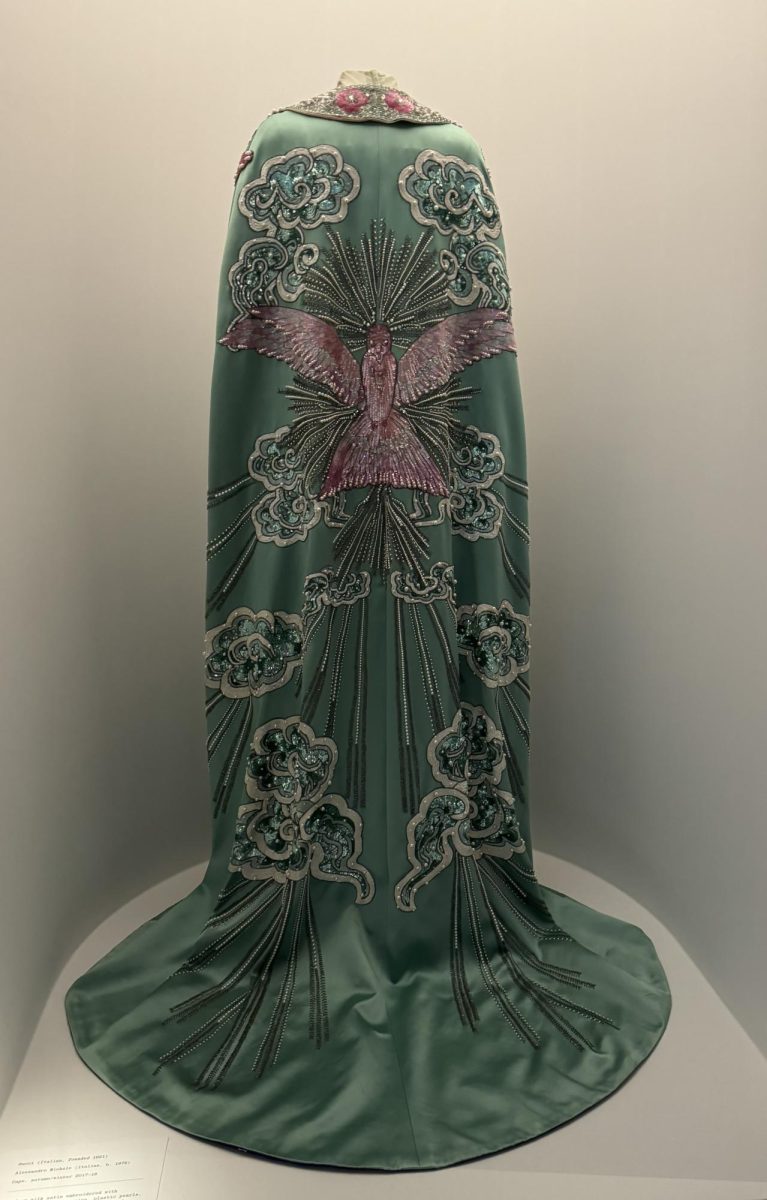With the whimsical chime of Disney’s Once Upon a Dream in the background, at first glance, the dusty gold face of sleeping beauty at the entrance of the museum glimmers in the light. As you walk further into the exhibit, you notice that every fragile dress along the walls interprets and expresses elements of nature. Each piece features delicate and fine stitching with seams sewn by some of the most luxurious brands.
The Costume Institute at The Metropolitan Museum of Art is currently abuzz with excitement as it unveils its latest spectacle, Sleeping Beauties: Reawakening Fashion. Curated by Andrew Bolton, the exhibit uses the transformative power of fashion to submerge the viewer in the beauty of nature. The exhibit is divided into various sections, each with its own theme, styles and interactions like scents or touch.
Emma Isaacs, a viewer of the exhibit visiting the city from New Jersey told me, “I thought the exhibit was really pretty. I liked how it was a story and everything connected like the different themes.”
The first sections that you walk through use flowers as the focal point. Whether painted or blurred, flowers have been a staple in fashion for the past 300 years. Painted flowers were common in the 1700s and 1800s where each piece of fabric was handcrafted in detail and used to showcase elegance. Painted flowers were used in dresses in Europe, but were heavily influenced by Chinese culture, as the silk used was exported from China, and the techniques were influenced by Chinese artistry.
Slightly past the Painted Flowers collection is the Blurred Blossoms collection. The blurred flowers were created using a technique called chiné à la branche, which is a procedure of repetitively dying threads and then weaving them together to create an illusion of watercolor flowers. Eventually, printmaking became a more popular method for design in modern dresses. Once again, this technique was inspired by Asian silk-making art, which later came to influence fashion in Europe.
A line of viewers admiring the Dior’s Garden section are treated to an exciting interactive feature. The exhibit allows viewers to stick out their hand and lightly grace the small 3D replica, the ‘Mini Miss Dior,’ to feel the intricate textures and fully understand the craftsmanship of the full-size dress.
Continuing the trend of flowers is a collection inspired by Vincent Van Gogh’s art. Each piece in this collection is stitched with individual beads of various shapes and colors, mimicking Van Gogh’s painting style. In the center of the room, a refined and structured jacket made by Yves Saint Laurent stands out. The production of the jacket was long and time-consuming; it took nine people and 600 hours to assemble, and the outcome is astonishing. On the ceiling of the exhibit, there is a video of the jacket up-close, showing each individual bead and sequin in focus, allowing viewers to appreciate the true technique that it took to produce the garment.
Placed side by side are two dresses from different designers with different interpretations of the poppy flower, which is often used to symbolize mortality. On the left, the dress, made by Ana de Pombo, was made after World War I and before World War II and is used to symbolize the blood on the hands, chest and feet of those who fought and died. While on the right, the dress, made by Ronald van der Kemp, is crafted out of leftover materials and shows the poppies as constantly growing. The two dresses stand in direct opposition to each other and reveal the endless cycle of life and death.
In a delicate glass case, a frail rose falls upside down, almost replicating the rose in Disney’s Beauty and the Beast. The red rose embodies love, passion and beauty with its fragile petals of a blush color. This section of the exhibit not only pleases the eyes, but also the nose. The designs smell of an aged rose perfume, with the scent lingering around the room.
Three sections focus specifically on scent. The Specter of a Rose uses old rose perfumes as inspiration. In the 1900s, perfume was very popular and often doused on dresses; many dresses from the 1900s still hold a slight musk from the perfume. To replicate the smells, there are sections on the wall that are made for people to rub and smell. Similarly, there is The Scent of a Woman and The Scent of a Man. The Scent of a Woman embraces the more intimate scents of women in a more personal and natural way, while The Scent of a Man highlights a perfume that was inspired by the scent of a man that the perfumer admired.
Perhaps one of the less fashionable pieces in the collection is a coat made by LOEWE, which has wheatgrass growing on it. Designer Jonathan Anderson collaborated with Paula Ulargui Escalona in order to produce a piece that shows the rebirth of fashion. A video shows the grass, which starts off as seeds, but then begins to sprout into flourishing green grass, and then eventually changes to a beige color. The wheatgrass not only represents life but also death, as the grass eventually changes color and dies. The efforts of Anderson and Ulargui Escalona are an attempt to convince people to reconnect with nature.
Insects and bugs were also a major source of inspiration within this exhibit. Insects, including beetles, may seem alarming to many people. However, they add an interesting texture to many designs. On the bodice of a beautiful silk-satin dress with pink flowers, you see spiders sewn onto it. The dress shows that insects are a part of nature and are evidently crawling everywhere, even on the most beautiful things.
With their small, dainty wings of a variety of patterns and colors, butterflies are used as a symbol of hope and life. Continuing the theme of rebirth, butterflies experience a unique life cycle where they begin as caterpillars and transform into butterflies. Many of the dresses in this exhibit are inspired by the distinct shapes of butterflies.
A beautiful orange dress made of feathers painted to showcase the monarch butterfly is most notably known as the dress worn by Effie Trinket, a character in The Hunger Games. Effie is a member of The Capital, which is the highest class in the movie series. The people of the Capital, especially Effie, are known for their extravagant outfits, and the attire of the people in the Capital is often compared to the style and extravagance of the Met Gala. A Met Museum employee, Trisha, told me, “My favorite dress is probably the McQueen dress, like the butterfly one, out of all of them, because butterflies are my favorite [she points to her shirt which has printed butterflies on it], and seeing that in person was really nice.”
Birds have been used as inspiration for many designs. In the section The Birds, there is an orange coat by Alexander McQueen as well as a black dress by Madeleine Vionnet. Multiple birds are shown, giving the appearance of them flying around to show movement. Birds are used to express movement, freedom, and death. In parallel, birds are not only used to symbolize death in fashion, but they are often killed for the reason of fashion. Within the section, The Nightingale and the Rose, taxidermy birds are showcased to show how people are abusing nature. An activist, Ryunosuke Okazaki, made a sculpture inspired by the shape of a bird’s skeleton in order to emphasize the meaningful message that humans should coexist and protect birds.
The ocean is known for its chaotic motions, which corresponds to the dresses within the collection Marine Life. Each of these dresses embodies the movement of the ocean, due to intense draping and irregular shapes. However, an issue that is emphasized in this collection is global warming and how it is negatively affecting marine life. Some of the dresses in this collection are made out of recycled ocean waste and materials, to combat the waste the fashion industry produces.
Venus, the Roman goddess of love, evokes beauty in fashion. Each of the dresses inspired by the goddess is flowing and distinctive, and each glimmering blotch similarly seems to personify the ocean. Most of the dresses within this exhibit are designed by some of the most luxurious fashion brands in order to show prestige. However, one dress of equal beauty was designed by the commercial brand, H&M. The blush pink dress, made out of recycled plastic, encapsulates the beauty of Venus and the ocean.
Two of the oceans’ mysteries are the mermaid and siren. A siren is deemed to be deathly when she entrances men with her addicting song. In African and Asian traditions, the siren equivalent is called the Mami Wata, which means the ‘Mother of Water.’ The shape and spirit of the siren are brought to life by the designs by Torisheju. The dresses are fully black and have an asymmetrical cut, similar to the tail of a siren. Within each fold, button and patch the dresses are dark and mysterious, just like a siren.
On the other hand, a mermaid is often thought of to be good-natured. The dresses within the Mermaid collection contrast with those in the Siren section because of their bright, illuminating colors. Four dresses stand side by side, and each one has sequins that make the dresses shimmer. Altuzarra, Michael Kors, Marc Jacobs and Norman Norell each created similar dresses of shiny, gold colors in order to emphasize the glamor of a mermaid. Alternatively, Phillip Lim and Stella McCartney strove to utilize eco-friendly materials in order to make their mermaid-inspired dresses. A dress made by Phillip Lim is made out of bamboo and bioplastic sequins, and the individual cut-outs of the shape of strands are sewn together in order to resemble seaweed. A dress made by Stella McCartney labeled “BioSequin” is made out of cellulose sequins. The dress is able to use the technique of sequining but replaces unbreakable plastic sequins with biodegradable ones in order to make a piece of fashion that is less harmful to the environment.
The final dress in this exhibit is a wedding dress worn by Natalie Potter for her wedding with William Conkling in 1930. The long, shiny dress in a cream color stands at the top of the steps and flows down. The dress mirrors the tail and scales of a mermaid with its skirt that extends into an extensive, elegant train. Inspired by the shape of shells and the waves of the ocean, designer Callot Soeurs truly created a stunning masterpiece.
I had the pleasure of speaking with Sally Chamberlin, a viewer of the exhibit who was visiting from the United Kingdom. She said, “The exhibit was absolutely spectacular. I think the story that the curators tell through different designers and different periods of fashion is really clearly represented. It was a really interesting and immersive experience.” Together, we had a laugh after she mentioned, “I wasn’t very keen on the scents,” and her friend then jumped in and said, “some of them we’re pretty stinky!”
The beauty of the Sleeping Beauties: Reawakening Fashion exhibit is that it is so versatile. There are so many elements that make it unique and allow it to stand out from typical fashion exhibits. Each of the sections has its own individual theme. However, they all connect together under the overall theme of nature. This is a must-see exhibit because of how spectacular it truly is. Don’t miss the chance to see Sleeping Beauties: Reawakening Fashion before it closes on Monday, September 2nd, 2024.


